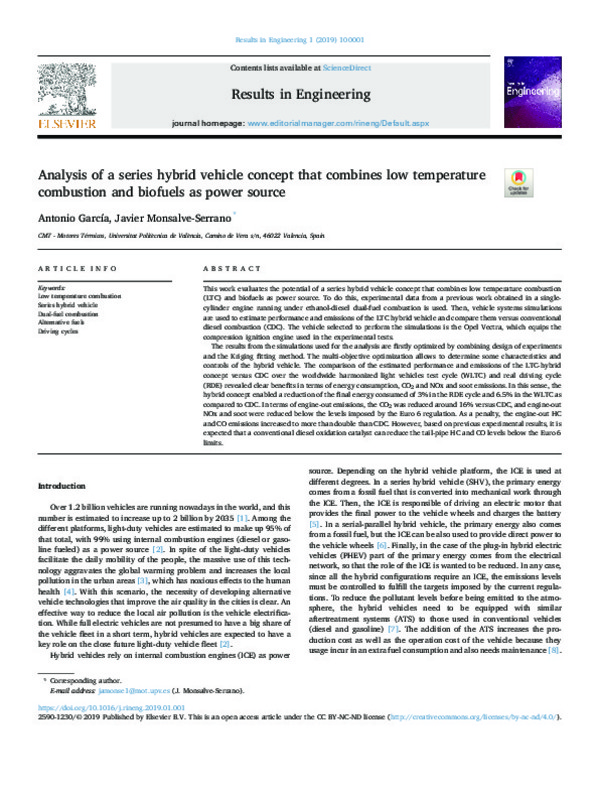Kalghatgi, G. (2018). Is it really the end of internal combustion engines and petroleum in transport? Applied Energy, 225, 965-974. doi:10.1016/j.apenergy.2018.05.076
Singh, S., & Kennedy, C. (2015). Estimating future energy use and CO2 emissions of the world’s cities. Environmental Pollution, 203, 271-278. doi:10.1016/j.envpol.2015.03.039
Engel, M. S., Paas, B., Schneider, C., Pfaffenbach, C., & Fels, J. (2018). Perceptual studies on air quality and sound through urban walks. Cities, 83, 173-185. doi:10.1016/j.cities.2018.06.020
[+]
Kalghatgi, G. (2018). Is it really the end of internal combustion engines and petroleum in transport? Applied Energy, 225, 965-974. doi:10.1016/j.apenergy.2018.05.076
Singh, S., & Kennedy, C. (2015). Estimating future energy use and CO2 emissions of the world’s cities. Environmental Pollution, 203, 271-278. doi:10.1016/j.envpol.2015.03.039
Engel, M. S., Paas, B., Schneider, C., Pfaffenbach, C., & Fels, J. (2018). Perceptual studies on air quality and sound through urban walks. Cities, 83, 173-185. doi:10.1016/j.cities.2018.06.020
Guanetti, J., Formentin, S., Corno, M., & Savaresi, S. M. (2017). Optimal energy management in series hybrid electric bicycles. Automatica, 81, 96-106. doi:10.1016/j.automatica.2017.03.021
He, H., & Guo, X. (2018). Multi-objective optimization research on the start condition for a parallel hybrid electric vehicle. Applied Energy, 227, 294-303. doi:10.1016/j.apenergy.2017.07.082
García Valladolid, P., Tunestål, P., Monsalve-Serrano, J., García, A., & Hyvönen, J. (2017). Impact of diesel pilot distribution on the ignition process of a dual fuel medium speed marine engine. Energy Conversion and Management, 149, 192-205. doi:10.1016/j.enconman.2017.07.023
Wu, H.-W., Wang, R.-H., Ou, D.-J., Chen, Y.-C., & Chen, T. (2011). Reduction of smoke and nitrogen oxides of a partial HCCI engine using premixed gasoline and ethanol with air. Applied Energy, 88(11), 3882-3890. doi:10.1016/j.apenergy.2011.03.027
Olmeda, P., García, A., Monsalve-Serrano, J., & Lago Sari, R. (2018). Experimental investigation on RCCI heat transfer in a light-duty diesel engine with different fuels: Comparison versus conventional diesel combustion. Applied Thermal Engineering, 144, 424-436. doi:10.1016/j.applthermaleng.2018.08.082
Yao, M., Zheng, Z., & Liu, H. (2009). Progress and recent trends in homogeneous charge compression ignition (HCCI) engines. Progress in Energy and Combustion Science, 35(5), 398-437. doi:10.1016/j.pecs.2009.05.001
Maurya, R. K., & Agarwal, A. K. (2011). Experimental investigation on the effect of intake air temperature and air–fuel ratio on cycle-to-cycle variations of HCCI combustion and performance parameters. Applied Energy, 88(4), 1153-1163. doi:10.1016/j.apenergy.2010.09.027
Singh, A. P., & Agarwal, A. K. (2012). Combustion characteristics of diesel HCCI engine: An experimental investigation using external mixture formation technique. Applied Energy, 99, 116-125. doi:10.1016/j.apenergy.2012.03.060
Yang, Y., Dec, J. E., Dronniou, N., & Sjöberg, M. (2011). Tailoring HCCI heat-release rates with partial fuel stratification: Comparison of two-stage and single-stage-ignition fuels. Proceedings of the Combustion Institute, 33(2), 3047-3055. doi:10.1016/j.proci.2010.06.114
Benajes, J., García, A., Monsalve-Serrano, J., Balloul, I., & Pradel, G. (2017). Evaluating the reactivity controlled compression ignition operating range limits in a high-compression ratio medium-duty diesel engine fueled with biodiesel and ethanol. International Journal of Engine Research, 18(1-2), 66-80. doi:10.1177/1468087416678500
García, A., Monsalve-Serrano, J., Rückert Roso, V., & Santos Martins, M. E. (2017). Evaluating the emissions and performance of two dual-mode RCCI combustion strategies under the World Harmonized Vehicle Cycle (WHVC). Energy Conversion and Management, 149, 263-274. doi:10.1016/j.enconman.2017.07.034
Benajes, J., García, A., Monsalve-Serrano, J., & Villalta, D. (2018). Exploring the limits of the reactivity controlled compression ignition combustion concept in a light-duty diesel engine and the influence of the direct-injected fuel properties. Energy Conversion and Management, 157, 277-287. doi:10.1016/j.enconman.2017.12.028
Benajes, J., García, A., Monsalve-Serrano, J., Balloul, I., & Pradel, G. (2016). An assessment of the dual-mode reactivity controlled compression ignition/conventional diesel combustion capabilities in a EURO VI medium-duty diesel engine fueled with an intermediate ethanol-gasoline blend and biodiesel. Energy Conversion and Management, 123, 381-391. doi:10.1016/j.enconman.2016.06.059
Benajes, J., García, A., Monsalve-Serrano, J., & Boronat, V. (2016). Dual-Fuel Combustion for Future Clean and Efficient Compression Ignition Engines. Applied Sciences, 7(1), 36. doi:10.3390/app7010036
Benajes, J., García, A., Monsalve-Serrano, J., & Boronat, V. (2017). An investigation on the particulate number and size distributions over the whole engine map from an optimized combustion strategy combining RCCI and dual-fuel diesel-gasoline. Energy Conversion and Management, 140, 98-108. doi:10.1016/j.enconman.2017.02.073
Benajes, J., García, A., Monsalve-Serrano, J., & Boronat, V. (2017). Gaseous emissions and particle size distribution of dual-mode dual-fuel diesel-gasoline concept from low to full load. Applied Thermal Engineering, 120, 138-149. doi:10.1016/j.applthermaleng.2017.04.005
Curran S, Hanson R, Wagner R. Reactivity controlled compression ignition combustion on a multi-cylinder light-duty diesel engine. Int. J. Engine Res. 13 (3), 216-225.
Reitz, R. D., & Duraisamy, G. (2015). Review of high efficiency and clean reactivity controlled compression ignition (RCCI) combustion in internal combustion engines. Progress in Energy and Combustion Science, 46, 12-71. doi:10.1016/j.pecs.2014.05.003
Olmeda, P., Martin, J., Garcia, A., Villalta, D., Warey, A., & Domenech, V. (2017). A Combination of Swirl Ratio and Injection Strategy to Increase Engine Efficiency. SAE International Journal of Engines, 10(3), 1204-1216. doi:10.4271/2017-01-0722
Luján, J. M., Bermúdez, V., Dolz, V., & Monsalve-Serrano, J. (2018). An assessment of the real-world driving gaseous emissions from a Euro 6 light-duty diesel vehicle using a portable emissions measurement system (PEMS). Atmospheric Environment, 174, 112-121. doi:10.1016/j.atmosenv.2017.11.056
OLIVER, M. A., & WEBSTER, R. (1990). Kriging: a method of interpolation for geographical information systems. International journal of geographical information systems, 4(3), 313-332. doi:10.1080/02693799008941549
Benajes, J., García, A., Monsalve-Serrano, J., & Villalta, D. (2018). Benefits of E85 versus gasoline as low reactivity fuel for an automotive diesel engine operating in reactivity controlled compression ignition combustion mode. Energy Conversion and Management, 159, 85-95. doi:10.1016/j.enconman.2018.01.015
García, A., Piqueras, P., Monsalve-Serrano, J., & Lago Sari, R. (2018). Sizing a conventional diesel oxidation catalyst to be used for RCCI combustion under real driving conditions. Applied Thermal Engineering, 140, 62-72. doi:10.1016/j.applthermaleng.2018.05.043
[-]









